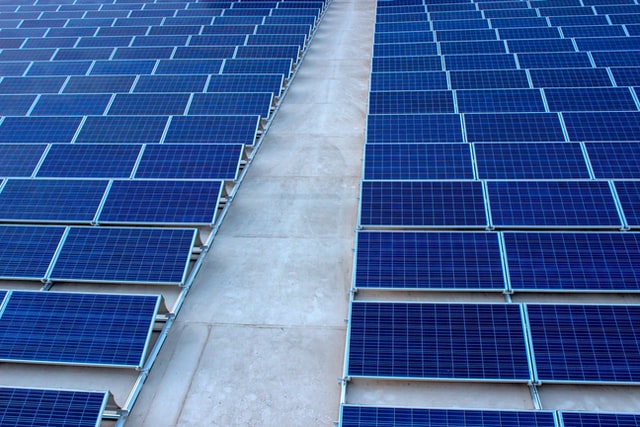Table of Contents
TogglePhotovoltaic solar power plants can generate enough electricity to power an entire neighbourhood or more, depending on its size and capacity, and more importantly its system.
There are three types of systems used by solar farms: off grid, on grid and hybrid. These systems can be divided into two sub-categories: for home and for commercial use.
A solar power plant installation consists of a few main components.
The smallest installation is usually the off grid system while grid-connected and hybrid solar power systems tend to have larger production capacities; thus, more components than the off grid type.
Main Components of a Solar Power System
The core component of any solar power system is the solar panel, without which solar energy cannot be converted into electricity. The other core component is the solar inverter.
Other components depend on whether the solar power system is on grid or off grid. They are the power optimiser, electricity switchboard, metering system, distribution panel, electric grid and battery bank.
Solar Panel
Solar panels consist of photovoltaic cells (PV cells) which generate direct current (DC) electricity from sunlight. The PV cells are linked together within the solar panel and connected to adjacent panels using cables.


Photo by Sungrow EMEA on Unsplash
Solar panels can generate electricity during cloudy and overcast weather, but the amount of energy depends on how much light can pass through the clouds.
The effective rate of solar panels also depends on the PV material used to make the semiconductors in the PV cells.
Most of the current PV materials are silicon-based but a wide range of other new materials are being implemented, researched on and improved for greater efficiency and lower production cost.
Solar Inverter
The DC electricity generated by solar panels often needs to be converted into alternating current (AC) electricity for direct use. The solar inverter plays this role.
A solar inverter may be linked to multiple solar panels. This arrangement is called a ‘string’ inverter system.
Another arrangement has one solar inverter linked to each solar panel. Micro inverters are used for this system which usually feeds electricity generated by the solar panels directly into an electrical switchboard.
Electrical Switchboard
The electrical switchboard draws AC electricity from a solar inverter into various circuits to power appliances directly. This component is usually necessary for systems set up for home consumption. More complex installations, such as the hybrid solar power system, have a backup switchboard.
Metering System
In a commercial set up, AC electricity from solar inverters are sent to a metering system. This is where the electricity is either stored or directed to an electric grid.
Power optimiser
More advanced string inverter systems have an additional component called a power optimiser. The power optimiser monitors and controls each panel individually as well as ensures every panel operates at maximum efficiency under all conditions.
Battery Bank
There are a few types of batteries used for solar energy storage:
- Lead-acid batteries (AGM and Gel)
- Lithium-ion batteries
- Redox flow batteries
- Sodium-ion batteries
Each type has different levels of capacity for storage and length of battery life.
Electric Grid
Also referred to as a power grid or electrical grid, it is a network of cables and poles which delivers electricity from producers to consumers.
Distribution Panel
It is also called a distribution board, panelboard, breaker panel or electric panel. A distribution panel helps to divide the supply of electrical power to subsidiary circuits. At the same time, it functions as an additional precautional circuit breaker for a circuit or network.
Types of solar power systems
Off Grid Solar Power System
Also called Stand Alone Solar Power Station, an Off Grid Solar Power System is not connected to an electricity grid. It is commonly used in remote locations where there is no pre-existing electric grid, or in home installations.
Since it is off grid, it usually has a battery bank to store excess electricity that is not utilised immediately. Other components of an off grid solar system include a solar controller aside from solar panel and solar inverter.
Small standalone systems normally generate less than 1kW. However, once the battery is filled to maximum capacity, the solar controller will stop the battery from being charged with DC electricity.
The DC electricity generated is flowed into the battery bank through the solar controller. Then, it is converted to AC by the solar inverter before being channelled to users or to electrical gadgets with more voltage needs.
For low-voltage use, DC can be flowed directly through the solar controller to the respective items, such as to power lights or charge laptops.
Electricity can be drawn from the battery bank during the night when there is no sunlight and the solar panels cannot function.
Some Stand Alone Solar Systems have a backup generator. The generator’s function is to fill in when the weather is too poor for solar panels to generate enough electricity.
On Grid Solar Power System
A facility based on the principle of an On Grid Solar Power System is also known as a Grid Tie Solar Power Station. As the name suggests, it is connected to a public electric grid.
This type of system is the most commonly used for home and commercial sectors. Its key differentiator from the off grid solar power system is its connection to the electric grid.
Because of this connection, it is not necessary for an on grid system to have a battery pack, but it is possible to add batteries into the installation.
Some countries allow home consumers with this system to sell excess or unutilised electricity back to the electricity utility company which is connected to the same electric grid.
During the night, when solar panels are unproductive, the utility company supplies power to homes through the grid.
A solar farm using this system requires a distribution panel, metering system and grid-tie inverter in order for the supply of electricity to be synced with the grid and AC supply to its consumers.
When the generated power reaches the switchboard in an on grid solar farm, it is run through the metering system. The metering system calculates how much of this power should be distributed or purchased.
The order and way in which switchboards and metering systems are used can vary in many parts of the world.
However, the similarity among them is that the solar farm or home solar system must be connected to the grid to function as an on grid system.
Hybrid Solar Power System
A hybrid system is a combination of the off grid and grid-connected systems. It allows for the storage of the off grid type while being connected to the electric grid like the on grid type.
This type of solar power system can function during a blackout, which is not a possibility for On Grid Solar Power Systems. This is because blackouts usually occur when the electricity grid is damaged.
Continuing to feed the grid with electricity is also a safety hazard for the workers who may be repairing the network. That is why the on grid type will cease function entirely in such situations.
Since a hybrid solar system has a battery bank, it is able to disconnect from a public electricity grid and continue to supply power during a blackout. Having a battery bank as part of the hybrid type also means that this stored reserve can be used 24-7.
Conclusion
All these types of solar power systems function based on the core principles of a photovoltaic solar power plant, one of the three major technologies in solar power plants.
PV panels and solar inverters are essential components of the on grid, off grid and hybrid solar power systems. The systems are, however, different from each other on the basis of their specifications and features.
Off grid solar systems are self-sufficient, be it for home or commercial applications. These come with battery banks and are suited for use in remote locations where connection to a public electric grid is difficult or unattainable.
However, because it is an enclosed system, owners of such a system cannot profit from surplus generated power. They also face limitations as to how much energy reserves can be stored, and have no backup should the reserve is depleted.
The on grid solar power system, on the other hand, must be linked to an electric grid. Home and commercial owners who are part of this type of system can gain from each other.
Surplus electricity generated by either can be sold to each other. However, if there were to be a blackout, the system must be disconnected from the grid for safety reasons, and there may be no backup.
The hybrid solar power system, being the newest technology, marries the best of both worlds and complements the weaknesses of the on grid and off grid version.
Also, read up on solar power meters and how they work.
Other related reading:






This Post Has One Comment
I intrested on study in this subject